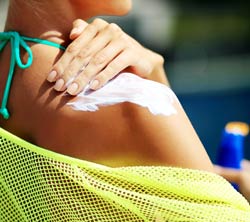 Be Safe in the Sun
Be Safe in the Sun
Working outdoors and being safe in the sun can be trickier than you think. Just because you don’t see the sun doesn’t mean it can’t hurt you. Cloudy days are no protection; ultraviolet (UV) rays still come through the clouds. The impact of sun damage can take anywhere from hours (sunburn) to years (skin cancer) to manifest — so it’s important to protect yourself and be vigilant for signs of melanoma that may mean skin cancer.
Nearly 5 million people are diagnosed with skin cancer every year, and if you’ve had five or more bad (blistering) sunburns, your chances of getting skin cancer increases by 80 percent. What should you do? If you have to be outside in the summer sun be sure to:
- Wear protective clothing (with a UPF rating), sunglasses and hats — and don’t count on just a cotton t-shirt, which only blocks about 20 percent of the sun’s rays.
- Use a broad-spectrum sunscreen with an SPF of 15 or higher
- Schedule breaks in the shade and reapply sunscreen throughout your shift.
- Bright or shiny surfaces amplify the sun’s rays, so cover autos or equipment with a tarp if possible.
- Schedule outdoor work early in the morning, and rotate shifts so as not to expose workers to strong sunlight for too long.
Who is at risk?
Skin cancer is treatable if caught early. Although considered a young person’s disease (attention lifeguards!), anyone who works in the sun without taking precautions is at risk of developing melanoma, a type of skin cancer where tumors originate in the skin cells. Just one bad sunburn doubles your risk. You may also have an increased risk to develop skin cancer if you have:
- More than 50 moles.
- Red hair and light skin.
- Weakened immune system.
- Family history of skin cancer.
It’s smart to have an annual checkup each year and to pay attention to moles that change size, shape or feel different. For more information about melanoma, click here to view a five-minute, in-service training video.
 Know Your Sunscreen Know Your Sunscreen
- There’s more to sunscreen than a dab or two on arms and legs. For best protection, choose one with a minimum SPF15 to protect against UVB rays (greatest chance of causing skin cancer) and check to see that it contains Mexoryl, Parsol 1789, titanium dioxide, zinc oxide or avobenzone to protect against UVA rays (responsible for skin aging).
- Check the expiration date of your sunscreen and toss any that are expired. If there is no expiration date, you can assume it is good for three years past the purchase date.
- Use it properly. Apply liberally at least 20 minutes before sun exposure and reapply every two hours or after being in the water. Be sure not to miss spots like the backs of hands and neck, scalp and ears.
|

